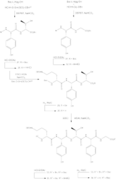Ramoplanin
 Structure of Ramoplanin A2, with the variable acyl sidechain in blue. | |
| Clinical data | |
|---|---|
| Routes of administration | Oral |
| ATC code |
|
| Legal status | |
| Legal status |
|
| Identifiers | |
| CAS Number | |
| PubChemCID | |
| ChemSpider | |
| UNII | |
| KEGG | |
| ChEBI | |
| ChEMBL | |
| ECHA InfoCard | 100.161.388 |
| Chemical and physical data | |
| Formula | C119H154ClN21O40 |
| Molar mass | 2554.10g·mol−1 |
| 3D model (JSmol) | |
| |
| |
Ramoplanin(INN) is a glycolipodepsipeptideantibioticdrug derived from strain ATCC 33076 ofActinoplanes.[1]It is effective againstGram-positivebacteria.[2]
Mechanism
[edit]It exerts its bacteriocidal effect by inhibitingcell wallbiosynthesis, acting by inhibiting the transglycosylation step ofpeptidoglycansynthesis.[3]Ramoplanin specifically binds to and sequesters lipid intermediates I and II, preventing intracellular glycosyltransferase (MurG) and other steps of the peptidoglycan assembly system.[4]
Uses
[edit]Its development has been fast-tracked by theU.S. Food and Drug Administrationas a treatment for multiple antibiotic-resistantClostridium difficileinfection of thegastrointestinal tract,[5]Unlikevancomycin,it is absorbed in the gastrointestinal tract, although it is unstable in the bloodstream, so can be taken only orally againstClostridium difficileinfections of the gastrointestinal tract.[6][7][8]
Ramoplanin is "particularly useful" in casesE. faecalisno matter its sensitivity tovancomycin.[2]
Chemistry
[edit]Ramoplanin is a mixture of three related compounds that vary in the acyl group on the Asn N-terminus, with the most abundant form (shown in the infobox) being A2.[4]: Fig. 1
Synthesis
[edit]Biosynthesis
[edit]The biosynthesis is performed by a 33-gene cluster containingnonribosomal peptide synthetasegenes and supporting enzymes for amino acid and fatty acid synthesis, revealed by sequencing of the producer strain in 2002. Initial investigation into the functions of individual genes was conducted in 2012.[9]
Total synthesis
[edit]The general synthesis of Ramoplanin A1, A2 and A3 aglycons entails the preparation of residues 3-9 (heptapeptide 15), pentadepsipeptide 26 (residues 1, 2 and 15–17) along with pentapeptide 34 (residues 10–14), subsequent coupling, and cyclization to create the 49-membered aglycon core of the compound.[10]The synthesis of Ramoplanin A2 aglycon and A3 aglycon are very similar to scheme 6, where ramoplanin A1 aglycon requires the corresponding acyl group andDMF,while ramoplanin A3 aglycon synthesis requires bothBu
4NF,i-PrOH,and then treatment with the acyl group and DMF.[4]
- Ramoplanin A2 Aglycon Synthesis
-
1 - Synthesis of Hpg3-Phe9 Subunit
-
2 - Fmoc-L-HAsn(Trt)-Obn Preparation
-
3 - Synthesis of Depsipeptide subunit
-
4 - Synthesis of Orn10-Gly14 Subunit
-
5 - Preparation of acyl group
-
6 - Deprotection
References
[edit]- ^Farver DK, Hedge DD, Lee SC (May 2005). "Ramoplanin: a lipoglycodepsipeptide antibiotic".The Annals of Pharmacotherapy.39(5): 863–868.doi:10.1345/aph.1E397.PMID15784805.S2CID6026698.
- ^abLee, V. J. (2007-01-01), Taylor, John B.; Triggle, David J. (eds.),"7.22 - Anti-Gram Positive Agents of Natural Product Origins",Comprehensive Medicinal Chemistry II,Oxford: Elsevier, pp. 653–671,doi:10.1016/b0-08-045044-x/00222-4,ISBN978-0-08-045044-5,retrieved2022-06-04
- ^Fang X, Tiyanont K, Zhang Y, Wanner J, Boger D, Walker S (January 2006). "The mechanism of action of ramoplanin and enduracidin".Molecular BioSystems.2(1): 69–76.doi:10.1039/b515328j.PMID16880924.
- ^abcShin D, Rew Y, Boger DL (August 2004)."Total synthesis and structure of the ramoplanin A1 and A3 aglycons: two minor components of the ramoplanin complex".Proceedings of the National Academy of Sciences of the United States of America.101(33): 11977–11979.doi:10.1073/pnas.0401419101.PMC514419.PMID15175429.
- ^Fulco P, Wenzel RP (December 2006). "Ramoplanin: a topical lipoglycodepsipeptide antibacterial agent".Expert Review of Anti-Infective Therapy.4(6): 939–945.doi:10.1586/14787210.4.6.939.PMID17181409.S2CID12881565.
- ^Scheinfeld N (January 2007). "A comparison of available and investigational antibiotics for complicated skin infections and treatment-resistant Staphylococcus aureus and enterococcus".Journal of Drugs in Dermatology.6(1): 97–103.PMID17373167.
- ^Balagopal A, Sears CL (October 2007). "Clostridium difficile: new therapeutic options".Current Opinion in Pharmacology.7(5): 455–458.doi:10.1016/j.coph.2007.05.007.PMID17644040.
- ^Gerding DN, Muto CA, Owens RC (January 2008)."Treatment of Clostridium difficile infection".Clinical Infectious Diseases.46(Suppl 1): S32–S42.doi:10.1086/521860.PMID18177219.
- ^Hoertz AJ, Hamburger JB, Gooden DM, Bednar MM, McCafferty DG (January 2012). "Studies on the biosynthesis of the lipodepsipeptide antibiotic Ramoplanin A2".Bioorganic & Medicinal Chemistry.20(2): 859–865.doi:10.1016/j.bmc.2011.11.062.PMID22222159.
- ^Jiang W, Wanner J, Lee RJ, Bounaud PY, Boger DL (February 2003)."Total synthesis of the ramoplanin A2 and ramoplanose aglycon".Journal of the American Chemical Society.125(7): 1877–1887.doi:10.1021/ja0212314.PMID12580615.






